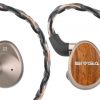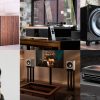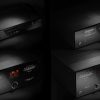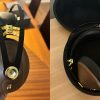Do we really need silver, oxygen-free copper and Teflon to make the best cables?
A lot of discussion of quality cables focuses on the materials used in cable construction. Just as with any physical product, the materials cables are made out of influence their performance characteristics, and so people want to know that the cables they're buying are made from the best possible materials.
Many high-priced cables are made with materials for which special claims of high performance are made. The most common among these are silver instead of or in addition to copper, "oxygen-free" copper, and Teflon. We'll address each of these in turn and explain what they are, what their characteristics are, and whether they make sense for particular applications.
Initially, it's perhaps helpful to point out that professional cables of the highest quality are routinely made without resort to any strange, exotic or expensive materials. If you look inside a typical audio or video production facility, you won't find it wired with silver-plated cables, oxygen-free copper cables, or (except, as we'll explain, in limited circumstances) Teflon-insulated cables. Broadcast studio engineers–people whose livelihood depends on the signal getting through with the lowest possible distortion and losses–rely on cables from companies like Belden and Canare, made with ordinary high-quality materials. People who spend millions of dollars on high-definition studio gear rely on these cables not because they're out to save a buck at the cost of quality, but because they are looking for the best possible product.
Let's take a look at some of these materials and consider how they bear on quality cable construction.
Silver or Silver-Plated Cables
Broadcast-quality cables are generally made with copper conductors; but it's not uncommon, in the consumer a/v market, to run into cables made with silver, or silver-plated copper, conductors. Why is this?
There is one respect in which silver is a better material for cable construction than copper: it is slightly (about 5%) less resistive (that is, more conductive) than annealed copper. "Resistance" is the property of any material which causes some of the electricity that flows through it to be converted into heat, and it's fair to say that resistance, in cables, is a bad thing–the less the better. All else being equal, lower resistance ought to be a good thing, and therefore one might think that silver would make for a better cable than copper.
That would indeed be so, but there are some other factors to take into account. First, the resistive loss in high-quality copper cables is already extremely small, because copper, though marginally less conductive than silver, is an extremely conductive metal. For example, Belden 1694A's center conductor resistance is 6.4 ohms per thousand feet. In a very long home theater run of 50 feet, then, the resistance of the conductor is 0.32 ohms, representing a minuscule cause of signal loss in a 75 ohm impedance video circuit; a solid silver conductor would drop this resistance by about five percent, resulting in a truly infinitesimal improvement.
This infinitesimal improvement might be worth something under extreme circumstances, all else being equal–but all else is rarely equal. First, silver is a more brittle material than copper, compromising the cable's flex-life. To solve this problem, silver is often plated over a copper wire–diminishing the conductivity benefit. Second, the conductivity benefit, as often as not, is offset by a reduction in wire gauge. Going from an 18 AWG conductor to a 20 AWG conductor, for example, results in an increase in resistance of over 50%; this swamps the conductivity benefit of silver, so that an 18 AWG copper conductor is more conductive, not less, than a 20 AWG silver or silver-plated conductor. When the comparison is between full-sized copper cables and silver-plated mini-coax of tiny gauge, like those one sees in many popular silver cable products, there's no contest; full-sized copper cables are dramatically more conductive, silver or no silver.
Oxygen-Free Copper
Many cables today are advertised as using "oxygen-free copper," copper which has been annealed in an oxygen-free atmosphere. OFC is popular in audio cables, and has begun to make inroads into the video cable market as well.
We all know, of course, that oxygen is bad for things made from copper. Copper oxidizes and turns green and flaky; in so doing, it loses its high conductivity and begins to fall apart. But the amount of oxygen present in conventionally annealed, non-OFC copper is so tiny that it simply isn't a factor in cable quality. We have cut into pieces of Belden coaxial cable twenty-five years old that have been used in radio transmission applications–and found them clean and bright, completely lacking any sign of oxidation. Modern coax is better still, with nitrogen-injected foam dielectrics that keep oxygen entirely away from the center conductor.
As it is with silver, there's nothing wrong with OFC; but electrically speaking, OFC wire is indistinguishable in audio and video applications from ordinary annealed copper wire.
Teflon Dielectrics and Insulation
Teflon is a special case, in one interesting sense: while audio and video cables made with silver or OFC are seldom used by professionals, there are plenty of professional-quality cables made with Teflon, for reasons we'll get to in a moment.
Teflon, of course, is familiar to us all as a coating on cookware; but it has certain interesting electrical properties as well which account for its use in cables. Insulating materials like Teflon vary in their ability to isolate conductors electrically from one another, and this property is characterized mathematically as the "dielectric constant." The best dielectric, from a purely electrical standpoint, is a vacuum; air is very nearly as good. But of course, when we're making coaxial cable, it's hard to use pure air as a dielectric because we need something relatively solid to keep the center conductor from coming into contact with, and shorting out to, the shield. A good dielectric for cable manufacture needs to be physically stable as well as having a good dielectric constant. Two materials that meet these criteria are polyethylene, used in the vast majority of precision video cables, and Teflon.
If we look at the characteristics of Teflon and polyethylene side-by-side, what becomes apparent is that Teflon has a lower dielectric constant; it is, in that sense, simply a "better" dielectric than polyethylene. If we were to make two coaxial cables, otherwise identical to one another, but produce one with polyethylene foam dielectric and the other with Teflon foam dielectric, the Teflon cable would have lower capacitance. Low capacitance being good, that'd be a good thing–right?
It would indeed; but there's a problem. The dielectric constant, capacitance, and the cable's characteristic impedance are all tied up together. If, in our example, the polyethylene cable had a 75 ohm characteristic impedance, for use in video, the Teflon cable would have a higher impedance, and would present an impedance mismatch if used in a video circuit. In order to correct the problem, we need to make the dielectric and shield smaller. When we get to 75 ohms impedance, we wind up with the same capacitance we had in the polyethylene cable. In other words, just because the Teflon is a "better" dielectric doesn't mean we get a "better" cable; it just means we don't need quite as much Teflon to achieve the same cable characteristics that we get using polyethylene.
Teflon's much more expensive, but a video cable with Teflon offers no performance enhancement over one made with polyethylene–so why the heck does anybody buy Teflon cables, anyhow? The answer has nothing at all to do with electrical performance, and everything to do with fire safety. Polyethylene, when exposed to fire, burns and gives off toxic fumes. This becomes an enormous hazard in a modern office building, where huge bundles of telephone and data cables are run through spaces which are also used for ventilation, because a fire in one part of a building can rapidly spread toxic fumes to the whole building. Teflon, by contrast, is highly fire-resistant and does not give off toxic fumes as easily. Because of this fire safety issue, cables which are routed through a plenum–that is, a dropped-ceiling area used as a ventilation return–are required to have a "plenum" rating, and Teflon, being both highly fire resistant and an excellent dielectric, is used in most plenum-rated cables.
Perhaps partly because of the higher cost of Teflon cables, some people believe that plenum versions of precision video cables perform better than their non-plenum counterparts. For example, one will sometimes see Belden 1695A, the plenum version of 1694A, recommended as a performance upgrade from 1694A. In fact, however, the performance specs on these two cables are virtually identical, and there is no reason to favor 1695A–unless, of course, you need that plenum fire rating.
We sell Teflon-dielectric cables, like Belden 1695A, alongside our polyethylene-dielectric offerings. If we thought that there were performance advantages to, say, Belden 1695A over Belden 1694A, we'd be the first to recommend it–but our experience has been that the two are, as the specs would suggest, completely indistinguishable. Teflon-based cables can be superb, but no more so than their less expensive, polyethylene equivalents; our recommendation is to use them if you need a plenum fire rating, but to save your money if you don't.
In Conclusion…
Fine materials and quality manufacturing practices make the best cables; but the best materials for cable manufacture aren't always the most exotic or fancy-sounding. Not only are quality copper wire and nitrogen-injected PE foam dielectric great materials for building a precision video cable, but manufacturers like Belden make the best use of these excellent materials by employing them in well-engineered manufacturing processes, with tight tolerances. The result: cables of the highest quality, relied upon worldwide by professional broadcast engineers when the quality of the signal is of the utmost importance.
by Blue Jeans Cable (reprinted with permission)




























